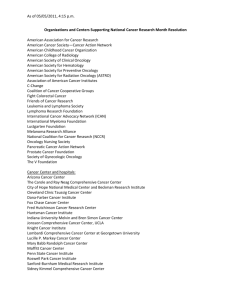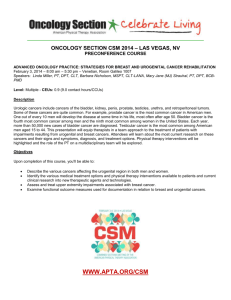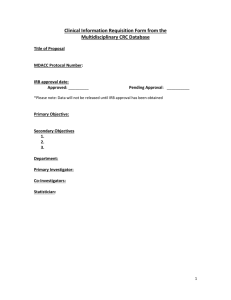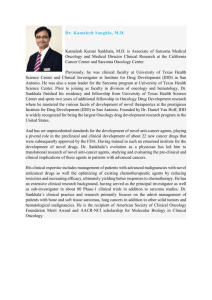Medical oncology prioritisation criteria
advertisement
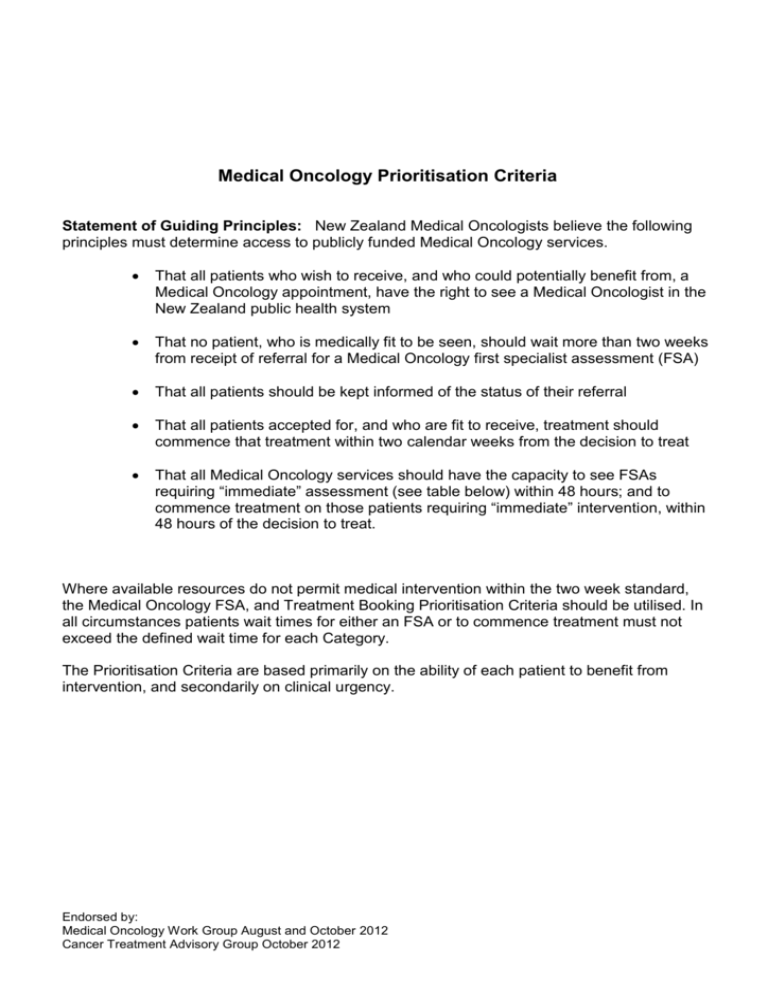
Medical Oncology Prioritisation Criteria Statement of Guiding Principles: New Zealand Medical Oncologists believe the following principles must determine access to publicly funded Medical Oncology services. That all patients who wish to receive, and who could potentially benefit from, a Medical Oncology appointment, have the right to see a Medical Oncologist in the New Zealand public health system That no patient, who is medically fit to be seen, should wait more than two weeks from receipt of referral for a Medical Oncology first specialist assessment (FSA) That all patients should be kept informed of the status of their referral That all patients accepted for, and who are fit to receive, treatment should commence that treatment within two calendar weeks from the decision to treat That all Medical Oncology services should have the capacity to see FSAs requiring “immediate” assessment (see table below) within 48 hours; and to commence treatment on those patients requiring “immediate” intervention, within 48 hours of the decision to treat. Where available resources do not permit medical intervention within the two week standard, the Medical Oncology FSA, and Treatment Booking Prioritisation Criteria should be utilised. In all circumstances patients wait times for either an FSA or to commence treatment must not exceed the defined wait time for each Category. The Prioritisation Criteria are based primarily on the ability of each patient to benefit from intervention, and secondarily on clinical urgency. Endorsed by: Medical Oncology Work Group August and October 2012 Cancer Treatment Advisory Group October 2012 Medical Oncology FSA Prioritisation Criteria Category 1 Immediate see within 48 hours 2 Urgent see within one week - 3 Semi-urgent - see within three weeks 4 Routine - see within four weeks Criteria Patients with responsive cancers who are severely symptomatic or in whom there is documented rapid progression; where if not treated quickly will suffer serious morbidity or threat to life All potentially curable cancers, where delay may jeopardise patient outcome Responsive cancers, with significant symptoms or documented rapid progression requiring urgent intervention Primary chemo-radiation* Known responsive cancers with defined prolongation of life/high chance of palliation Proven adjuvant therapies, (high/moderate risk) Adjuvant chemo-radiation* 5 Advice only - letter to referrer, no appointment offered Examples Burkitt’s lymphoma Choriocarcinoma Superior vena caval obstruction in diagnosed, chemotherapy responsive, cancers e.g. NHL, small cell lung cancer Advanced germ cell tumour testis/ovary Aggressive non-Hodgkin’s lymphoma Hodgkin’s lymphoma Small cell lung cancer Breast cancer Colorectal cancer (adjuvant/advanced) Inflammatory breast cancer Ovarian cancer Low grade lymphoma (bulky or symptomatic) Adjuvant NSCLC Cancers with known Low grade NHL, low bulk, no indolent behaviour symptoms Less responsive cancers Palliative chemotherapies of with limited treatment poorly responsive cancers, eg: benefits melanoma, soft tissue sarcoma (non-paediatric), renal cell cancer Low risk adjuvant treatment (< 5% survival benefit) Adjuvant stage II colon cancer Straightforward clinical issue, not requiring chemotherapy No, or poorly defined, treatment options Very low or unlikely benefit from treatment *Some patients prioritised may have their assessment delayed due to the timing of other treatment. Endorsed by: Medical Oncology Work Group August and October 2012 Cancer Treatment Advisory Group October 2012 Medical Oncology Treatment Booking Priority (Maximum wait times from the decision to treat) Category A Immediate - within 48 hours Criteria Responsive cancers with rapidly progressive malignancy or complication of malignancy, where if not treated will suffer serious morbidity or threat to life B Semi-urgent - within two weeks* C Routine - within four weeks All potentially curative cancers High risk adjuvant therapy Responsive cancer with evidence of rapid progression, which if not treated promptly may give rise to major complications or worsening of prognosis Concurrent chemotherapy and radiotherapy All other cases of adjuvant and palliative systemic treatment Examples Advanced germ cell tumour testis with evidence of rapid progression, aggressive non-Hodgkin’s lymphomas with severe symptoms of rapid progression Burkitt’s lymphoma Superior vena caval obstruction in chemotherapy responsive cancers Aggressive non-Hodgkin’s lymphoma Hodgkin’s lymphoma Small cell lung cancer Undebulked ovarian cancer Highly node-positive breast cancer * Within Category B there may be certain patients who, while not requiring Immediate intervention, need to commence treatment before 2 weeks. Such cases, and the necessary time to start of treatment should be identified by the prioritising Medical Oncologist. Endorsed by: Medical Oncology Work Group August and October 2012 Cancer Treatment Advisory Group October 2012
